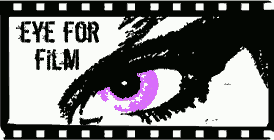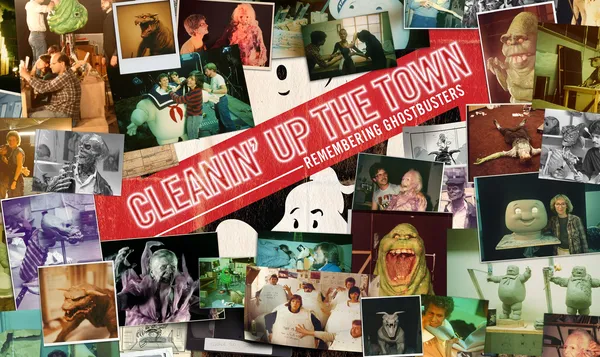 |
| Cleanin' Up The Town: Remembering Ghostbusters |
Anthony and Claire Bueno's Cleanin' Up The Town: Remembering Ghostbusters was a 12-year-long odyssey to tell the story of the making of the 1984 cult classic — a film that holds a special place in both their hearts. They are not ones to shirk a Herculean task, and neither has stopped there. The pair have just completed the film documentary Too Hot To Handle: Remembering Ghostbusters II, and Claire has taken the interviews from the first documentary and collated them into the chronological scene-by-scene conversation Cleanin' Up The Town: Remembering Ghostbusters, A Cast And Crew's Memoir Of Ghostbusters.
In conversation with Eye For Film, Claire remembers seeing Ghostbusters for the first time, and the part it has played in their lives. She also discusses the decision to embrace the task of writing the book, tying in their own filmmaking experiences, and their memories of becoming a part of a community.
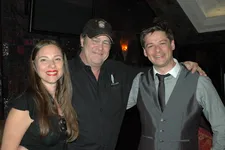 |
| Claire Bueno, Dan Aykroyd and Anthony Bueno |
Paul Risker: How did you first discover Ghostbusters, and over the years, how has your relationship with the film evolved?
Claire Bueno: I first discovered Ghostbusters when I was a teenager, when I went to see it at the cinema back in 1984. It was the first film I was permitted to go and see without parental supervision, so it was a seminal film in that sense. It was also a film I recommended to my younger brother Anthony, who totally fell in love with it and who truly carried the torch for it over the years. It hugely influenced him in his love of film and the paranormal.
It was Anthony who approached me about doing a deep-dive retrospective documentary about the making of Ghostbusters and Ghostbusters II. It unexpectedly took us 12 years to make what became Cleanin' Up The Town: Remembering Ghostbusters, and five years later, we have just completed Too Hot To Handle: Remembering Ghostbusters II. So, both films have been a big part of our adult lives for just shy of 20 years.
On a personal level, how my relationship has evolved over the years is that this isn’t a film that I just enjoyed as a child anymore, but both films are movies that I have a huge amount of respect for. Even after all these years and knowing it so well, we still sit and make a choice to watch either film when they come on the TV.
PR: I remember Robert Rodriguez saying something along the lines of: we re-watch films, not to watch the film from beginning to end, but for specific moments. Would you agree, and are there any moments from Ghostbusters and Ghostbusters II that represent these moments?
CB: I had never thought of it that way, but he has a very good point. Yeah absolutely, and the specific moment for me in Ghostbusters is when the librarian ghost transforms at the beginning of the film. I remember being so scared I literally jumped out of my seat in the cinema. I recall looking around, embarrassed, and laughing at myself. When the Ghostbusters run out of the New York Public Library like scaredy-cats, it just perfectly sets up the audience’s expectations.
In Ghostbusters II, it has to be the courtroom/Scoleri Brothers scene that totally taps into my fascination with true crime. [Laughs] In Too Hot To Handle: Remembering Ghostbusters II, I loved diving in and researching the inspiration behind those two characters.
PR: After releasing Cleanin' Up The Town, what was the thought process behind the book?
CB: After releasing Cleanin' Up The Town: Remembering Ghostbusters, we were truly overwhelmed by the response. People just loved it, I’m proud to say. A friend of ours, Richard Latto, who became my trusted and valued editor, approached me about writing a book. There were so many stories that didn’t fit the narrative of the film that would have been left on the cutting room floor, so why not turn that into a book and create the definitive oral history of the making of Ghostbusters? With the doc, we had to strike a balance between providing enough detail to satisfy the hardcore fans but not making it so dense that it alienates a more casual viewer. With the book you can throw it all in.
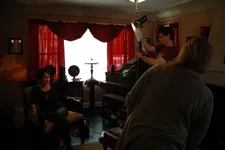 |
| The crew prepares to film Annie Potts |
We also experienced our own Herculean task of making the doc which people often ask us about. I thought this would be an excellent opportunity to tell our own story, so if anyone wants to go out and make a documentary themselves, they can hopefully learn from some of our successes and failures.
Sitting at 577 pages, this hardback book is a beast [laughs]. It's unapologetically big and beautiful — I call it 'substantial inside and out.' But everything is there — everything and everyone we interviewed from in front and behind the camera, including Dan Aykroyd, Harold Ramis, Ernie Hudson, Sigourney Weaver, Ivan Reitman, VFX maestro Richard Edlund, and accounts from over 50 people have been committed to history. It is really important to both Anthony and I that we share their legacy with the world.
PR: Cinema is an ongoing conversation that transcends the release window and the immediacy of the experience. Your point about committing all of these accounts to history reminds me of the idea that art needs to be discussed to thrive.
CB: One hundred percent, and I like to think art evokes an emotion. Whether you like it or dislike it, you have a reaction — you feel something. It's sad when you walk out of a movie feeling nothing other than, ‘Right, where are we going for something to eat?’ or ‘Okay, if I run, I’ll catch my bus or train.’ It’s instantly dismissed.
We love talking about film, and as you say, it keeps it alive. When we cast our minds back to the Eighties, we’d see a film and then months later there’d be a VHS release, which gave us all that anticipation and something to talk about and look forward to. Do you remember talking to your friends, saying "I can’t wait for XYZ to come out on tape or disc?" In our world of immediacy, you don’t have that now. Everything feels sadly disposable, as we move swiftly on to the next thing. Yet how hard has everyone worked to make that film? Anthony and I often chat about what film made today is so iconic that would prompt anyone to go out and make a retrospective making of. I digress a little, but talking about it and keeping it in public consciousness is vital.
PR: Are there any parts of the story you were unable to include in the documentary, which you're pleased to have shared in the book?
CB: New York, for me, is a character in the film, but in the world of Ghostbusters it is very rarely explored. Having visited there to do the doc, I loved it and I felt very safe. It turns out it was a very different city than it was in the Eighties, where it was a dangerous place to be. It’s important because I feel it gives greater context to the world the characters were inhabiting and the obstacles they faced.
Another story is that the Ghostbusters are doctors of parapsychology, so I have interviewed real-life doctors of parapsychology to gain a greater understanding of the science which Dan Aykroyd grounds the film in. That was a fun, but an important chapter.
The book was also an excellent opportunity to reach out to people who eluded us the first time round — people like Reginald VelJohnson, who plays the prison guard. It's the first time he has spoken publicly about working on the film, so that in itself has been very rewarding.
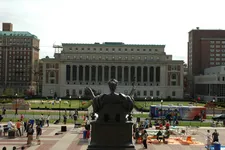 |
| Columbia University |
PR: We’ve both been in the journalist game for long enough to know interviewing can be a mixed bag of experiences. Eye For Film's Andrew Robertson, in his review, suggested that to say trying to get Bill Murray was 'famously difficult' is an understatement. It appears that the interviews have left you with lots of memories and are stories in themselves. Are there any you’d be willing to share?
CB:The dearly departed Harold Ramis was truly wonderful and, without doubt, as one of the co-writers of Ghostbusters, formed the backbone of the documentary. When we went to his very unassuming office above a row of shops in a Chicago suburb, he opened the door with "It’s the Ghostbusters!" We were so nervous, yet in one sentence he instantly disarmed us. That really sums up the calibre of the man.
The whole interview was a dream. He would ask his PA to put off his other appointments for the day so he could continue talking to us. He even apologised and asked if he was talking too much. Can you imagine? What a treasured memory. We learned a lot from him in every way.
To my knowledge, we were the last people Harold spoke to at length about his time working on Ghostbusters and Ghostbusters II. Our biggest regret was that we never finished our film in time before his passing. I truly hope we made him proud and worthy of his time.
PR: Your experience of interviewing Harold Ramis aside, were some of the interviews a case of compromising on what you could ask, given time constraints? And if you still have one or two burning questions you’d like to ask, what would they be and to whom?
CB: I laugh because, 99% of the time, time was not an issue — everyone was happy to give us what time we needed. But when we interviewed Ivan Reitman, the director of Ghostbusters, we got so far in when he announced he was tired. We weren’t even halfway through; I had pages of questions. I really had to think on the fly and cherry-pick what I thought Anthony would need for the edit. So, the pressure was on. You could clearly see he’d had enough, and I kept asking him stuff like, "Can you just say to camera, ‘pick up the phone and call the professionals'?" And "Can you say ‘Ghostbusters’ to camera please?" It was all stuff we needed for the film. In fairness, he humoured me and graciously facilitated, but I truly wanted the earth to swallow me up.
If I had two burning questions it would have been to Rick Moranis. He was sadly the one person who declined our invitation. Absolutely everyone, without exception, spoke of him with such high esteem. He developed Louis Tully himself from a blank canvas. So, I would dearly love to ask him about the evolution of the character and how he inhabited that part — it’s a genius performance.
PR: What were some of the challenges of writing the book?
CB: When I first began typing the transcripts, that was challenging because of the volume of interviews. I typed it all by hand and did not use any transcribing software. I felt it was important for me to reconnect to the interviews I'd conducted. My foot pedal became my best friend!
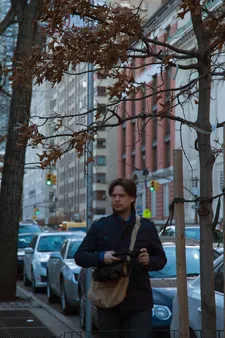 |
| Anthony Bueno |
The second big challenge was the edit. This book is an oral history, not a book of transcribed interviews. The book is very much an extension of the doc, so we follow the chronology of the film scene by scene. I wanted to create an environment where the reader feels they are sat and nestled in a room with all of these great people as they discuss together the making of the film. So, visiting each interview, finding corresponding extracts and editing them together was fun but challenging.
The biggest challenges by far were the cinematography and visual effects chapters. This is a book about filmmaking of the period. We go into great depth, talking about cameras, lighting and creating visual effects, which we have to remember is all pre-digital — everything is practical and in-camera. As a film journalist, I don’t have any experience in VFX, for example, so it really gave me a headache making sure everything was factually accurate.
PR: Do you think Cleanin' Up The Town is an optimistic or cynical work on film production/filmmaking, or is it simply honest? I ask because filmmakers talk to me about how difficult making a film is, and yet they wouldn't want to do anything else. They'll even say it can be like an addiction.
CB: One hundred percent honest. There is a chapter that was particularly painful to write from our personal story. When reading it back over and over, again and again, as you do when you’re at the editing stage, it didn’t get any less painful to read. In fact, I think it exacerbated my anxiety having to recall what happened. It would have been much easier for me to just cut it out or not write it at all. But I felt it important that I give an honest account of what happened to us — warts and all.
With respect to the making of Ghostbusters, we have to remember we were interviewing people who were at least 20–25 years removed from when they were shooting the film back in 1983, and so that comes with a certain perspective. The book, and the doc, I would say are optimistic. They are both a celebration of the hugely talented people who, when they came together, the planets aligned, and they made lightening in a bottle.
PR: Picking up on your point about interviewing people 20–25 years removed, perhaps memory plays an interesting part here. Is there a joy or something special about the realisation that memory might blur the exact details? Is it fun that there might be a separation between how it’s remembered and what actually happened?
CB: Yeah, you got it in one. I have a company called Premiere Scene, where I have interviewed a lot of people on the red carpet as they promote their latest film. The talent is there to sell the film. The reactions to questions are different because they are current — they are still actively working and therefore more considered in their answers. Whereas when you interview for a retrospective film, the filter is off a little, particularly if they are retired from the industry. They don’t say anything defamatory, but they do talk with a candidness.
With a film like Ghostbusters that was a huge success and globally launched a lot of people, it is easier to look back on their success with affection. And you’re right regarding the accuracy of the information. People remember things a certain way, and so it is important to get accounts to corroborate accuracy. For example, there was a whole debate at the time about the height of the Stay Puft Marshmallow Man. We were able to get various contributors who were able to verify that his original height was 112.5ft.
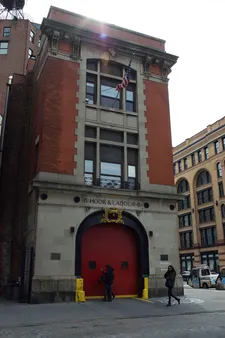 |
| The famous Ghostbusters fire station |
PR: There’s the story we see onscreen, then there’s the behind-the-scenes story. It’s so interesting that we want to suspend our disbelief, and yet even as we’re watching a film, there’s a part of us that’s conscious we’re watching a film. Then, there’s the desire to know everything about how a film was made. Our relationship to cinema is riddled with contradictions. What does the appetite to know about behind-the-scenes stories say about us on a human level, and our relationship to storytelling and art?
CB: John Bruno, who was visual effects art director on Ghostbusters, said "What goes on behind the scenes of a film is often more interesting than the film itself." He’s not wrong. I think when there is a film we really enjoy, we just can’t get enough of it, and knowing what goes on behind the scenes is a new way of experiencing the film and perhaps getting to know the people who made it a little better. I also think it’s human nature to be curious and inquisitive.
You pose an interesting question though — we watch a film for escapism, yet we break the mystique by wanting to know the facts behind it. Aren’t humans a paradox?! [Laughs]. Ultimately, humans have an insatiable appetite for whatever they like that is rarely satisfied. Money is a great example — when is enough, and when do you stop wanting more?
PR: What has surprised you most about the journey from the documentary to the book?
CB: My resilience! My ability to bounce back against the odds. What I didn’t expect, and what has surprised me the most, is how we have been embraced by those we interviewed, who we now call our friends, particularly those from the VFX team. You hear about the cut-throat world of Hollywood, which without doubt has that element. But we have met some of the most truly talented and nicest people you could ever wish to meet. Over all the years it took us to make the film, and now the book, they never lost faith in us and have generously continued to support and help us over the years. We are honoured and have been truly blessed.
PR: Has making the documentary and writing the book been a transformative experience?
CB: Absolutely. We are not ‘connected’ people. We grew up in a seaside town in South Devon, yet we dared to dream. I’m a firm believer in living life to the full and embracing all experiences. There is no such thing as a bad experience but a life lesson — it’s how we learn from events that evolve us as human beings.
I was a teenager around the time of seeing Ghostbusters, and I wanted to be a writer but was told to be realistic and think about getting a ‘real’ job. I did a ‘real’ job, then jumped off the treadmill. I’ve met amazing people and had equally amazing experiences. Here I am, four decades later, a début author. If anything, I’ve learned to be resilient — tomorrow is another day, and never give up on your dreams.
Cleanin' Up The Town: Remembering Ghostbusters is available on Blu-Ray from Screenbound, and Cleanin' Up The Town: Remembering Ghostbusters, A Cast And Crew's Memoir Of Ghostbusters is available to buy from Amazon, HMV and Zavvi. For more information click here.
